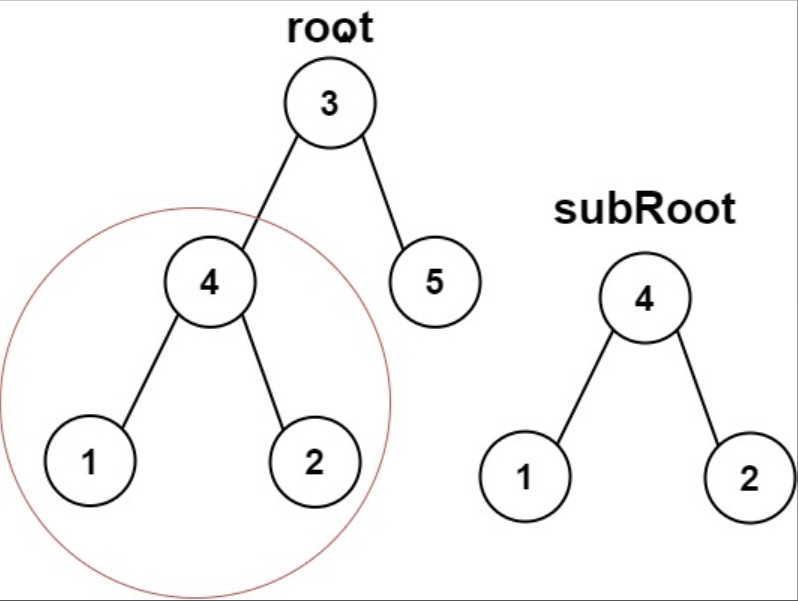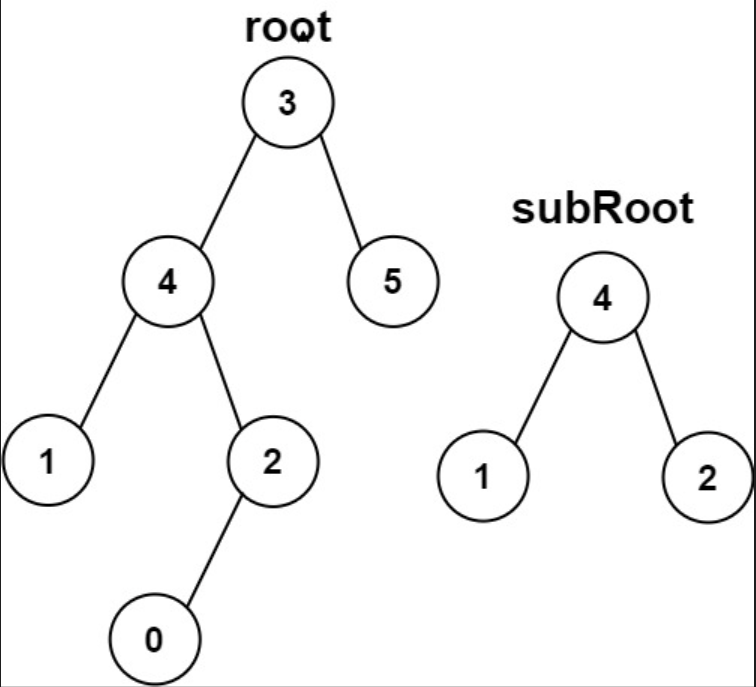2024/1/23大约 4 分钟
一、题目描述
给你两棵二叉树root和subRoot。检验root中是否包含和subRoot具有相同结构和节点值的子树。如果存在则返回true;否则返回false。
二叉树tree的一棵子树包括tree的某个节点和这个节点的所有后代节点。tree也可以看做它自身的一棵子树。
示例 1
输入: root = [3, 4, 5, 1, 2], subRoot = [4, 1, 2]
输出: true
示例 2
输入: root = [3, 4, 5, 1, 2, null, null, null, null, 0], subRoot = [4, 1, 2]
输出: false
提示
root树上的节点数量范围是[1, 2000]subRoot树上的节点数量范围是[1, 1000]-10⁴ <= root.val <= 10⁴-10⁴ <= subRoot.val <= 10⁴
相关主题
- 树
- 深度优先搜索
- 二叉树
- 字符串匹配
- 哈希函数
二、题解
Rust节点定义
#[derive(Debug, PartialEq, Eq)]
pub struct TreeNode {
pub val: i32,
pub left: Option<Rc<RefCell<TreeNode>>>,
pub right: Option<Rc<RefCell<TreeNode>>>,
}
impl TreeNode {
#[inline]
pub fn new(val: i32) -> Self {
TreeNode {
val,
left: None,
right: None,
}
}
}Java节点定义
public class TreeNode {
int val;
TreeNode left;
TreeNode right;
TreeNode() {}
TreeNode(int val) { this.val = val; }
TreeNode(int val, TreeNode left, TreeNode right) {
this.val = val;
this.left = left;
this.right = right;
}
}方法 1: 深度优先搜索暴力匹配
Rust
pub fn is_subtree(root: Option<Rc<RefCell<TreeNode>>>, sub_root: Option<Rc<RefCell<TreeNode>>>) -> bool {
Self::dfs_recur_match(root, sub_root)
}
///
/// 时间复杂度: O(|r| * |s|)
/// 空间复杂度: O(max(dr, ds))
///
fn dfs_recur_match(
root: Option<Rc<RefCell<TreeNode>>>,
sub_root: Option<Rc<RefCell<TreeNode>>>,
) -> bool {
const CHECK: fn(Option<Rc<RefCell<TreeNode>>>, Option<Rc<RefCell<TreeNode>>>) -> bool =
|root, sub_root| match (root, sub_root) {
(None, None) => true,
(Some(root), Some(sub_root)) => {
if root.borrow().val != sub_root.borrow().val {
return false;
}
CHECK(root.borrow().left.clone(), sub_root.borrow().left.clone())
&& CHECK(root.borrow().right.clone(), sub_root.borrow().right.clone())
}
_ => false,
};
const DFS: fn(Option<Rc<RefCell<TreeNode>>>, Option<Rc<RefCell<TreeNode>>>) -> bool =
|root, sub_root| match root {
None => false,
Some(root) => {
let left = root.borrow().left.clone();
let right = root.borrow().right.clone();
CHECK(Some(root), sub_root.clone())
|| DFS(left, sub_root.clone())
|| DFS(right, sub_root)
}
};
DFS(root, sub_root)
}Java
public boolean isSubtree(TreeNode root, TreeNode subRoot) {
return this.dfsRecurMatch(root, subRoot);
}
BiFunction<TreeNode, TreeNode, Boolean> check = (root, subRoot) -> {
if (root == null && subRoot == null) {
return true;
} else if (root != null && subRoot != null) {
if (root.val != subRoot.val) {
return false;
}
return this.check.apply(root.left, subRoot.left)
&& this.check.apply(root.right, subRoot.right);
} else {
return false;
}
};
BiFunction<TreeNode, TreeNode, Boolean> dfs = (root, subRoot) -> {
if (root == null) {
return false;
}
return this.check.apply(root, subRoot)
|| this.dfs.apply(root.left, subRoot)
|| this.dfs.apply(root.right, subRoot);
};
/**
* 时间复杂度:O(|r| * |s|)
* 空间复杂度:O(max(dr, ds))
*/
boolean dfsRecurMatch(TreeNode root, TreeNode subRoot) {
return this.dfs.apply(root, subRoot);
}方法 2: 深度优先搜索序列上做串匹配
Rust
pub fn is_subtree(root: Option<Rc<RefCell<TreeNode>>>, sub_root: Option<Rc<RefCell<TreeNode>>>) -> bool {
Self::dfs_sequence_match(root, sub_root)
}
///
/// 时间复杂度: O(|r| + |s|)
/// 空间复杂度: O(|r| + |s|)
///
fn dfs_sequence_match(
root: Option<Rc<RefCell<TreeNode>>>,
sub_root: Option<Rc<RefCell<TreeNode>>>,
) -> bool {
const GET_MAX_ELEMENT: fn(&Option<Rc<RefCell<TreeNode>>>) -> i32 = |root| match root {
None => i32::MIN,
Some(curr) => {
let max_child = std::cmp::max(
GET_MAX_ELEMENT(&curr.borrow().left),
GET_MAX_ELEMENT(&curr.borrow().right),
);
std::cmp::max(max_child, curr.borrow().val)
}
};
let max_elem = std::cmp::max(GET_MAX_ELEMENT(&root), GET_MAX_ELEMENT(&sub_root));
let (l_null, r_null) = (max_elem + 1, max_elem + 2);
let get_dfs_order = |root| {
let mut vals = vec![];
const GET_DFS_ORDER: fn(Option<Rc<RefCell<TreeNode>>>, &mut Vec<i32>, i32, i32) =
|root, vals, l_null, r_null| {
if let Some(curr) = root {
vals.push(curr.borrow().val);
let left = curr.borrow_mut().left.take();
let right = curr.borrow_mut().right.take();
if left.is_some() {
GET_DFS_ORDER(left, vals, l_null, r_null);
} else {
vals.push(l_null);
}
if right.is_some() {
GET_DFS_ORDER(right, vals, l_null, r_null);
} else {
vals.push(r_null);
}
}
};
GET_DFS_ORDER(root, &mut vals, l_null, r_null);
vals
};
let root_vals = get_dfs_order(root);
let sub_vals = get_dfs_order(sub_root);
let kmp = || {
let root_len = root_vals.len();
let sub_len = sub_vals.len();
let mut fail = vec![-1; sub_len];
let mut j = -1_i32;
for i in 1..sub_len {
while j != -1 && sub_vals[i] != sub_vals[(j + 1) as usize] {
j = fail[j as usize]
}
if sub_vals[i] == sub_vals[(j + 1) as usize] {
j += 1;
}
fail[i] = j;
}
j = -1;
for i in 0..root_len {
while j != -1 && root_vals[i] != sub_vals[(j + 1) as usize] {
j = fail[j as usize];
}
if root_vals[i] == sub_vals[(j + 1) as usize] {
j += 1;
}
if (j + 1) as usize == sub_len {
return true;
}
}
false
};
kmp()
}Java
public boolean isSubtree(TreeNode root, TreeNode subRoot) {
return this.dfsSequenceMatch(root, subRoot);
}
Function<TreeNode, Integer> getMaxElem = (root) -> {
if (root == null) {
return Integer.MIN_VALUE;
}
int maxChild = Math.max(this.getMaxElem.apply(root.left), this.getMaxElem.apply(root.right));
return Math.max(maxChild, root.val);
};
@FunctionalInterface
interface QuadrConsumer<A, B, C, D> {
void accept(A a, B b, C c, D d);
}
QuadrConsumer<TreeNode, Integer, Integer, List<Integer>> getDfsOrder = (root, lNull, rNull, vals) -> {
if (root == null) {
return;
}
vals.add(root.val);
if (root.left != null) {
this.getDfsOrder.accept(root.left, lNull, rNull, vals);
} else {
vals.add(lNull);
}
if (root.right != null) {
this.getDfsOrder.accept(root.right, lNull, rNull, vals);
} else {
vals.add(rNull);
}
};
BiPredicate<List<Integer>, List<Integer>> kmp = (rootVals, subVals) -> {
int rootSize = rootVals.size();
int subSize = subVals.size();
int[] fail = new int[subSize];
Arrays.fill(fail, -1);
for (int i = 1, j = -1; i < subSize; i++) {
while (j != -1 && !Objects.equals(subVals.get(i), subVals.get(j + 1))) {
j = fail[j];
}
if (Objects.equals(subVals.get(i), subVals.get(j + 1))) {
j++;
}
fail[i] = j;
}
for (int i = 0, j = -1; i < rootSize; i++) {
while (j != -1 && !Objects.equals(rootVals.get(i), subVals.get(j + 1))) {
j = fail[j];
}
if (Objects.equals(rootVals.get(i), subVals.get(j + 1))) {
j++;
}
if (j + 1 == subSize) {
return true;
}
}
return false;
};
/**
* 时间复杂度:O(|r| + |s|)
* 空间复杂度:O(|r| + |s|)
*/
boolean dfsSequenceMatch(TreeNode root, TreeNode subRoot) {
int max = Math.max(this.getMaxElem.apply(root), this.getMaxElem.apply(subRoot));
int lNull = max + 1;
int rNull = max + 2;
List<Integer> rootVals = new ArrayList<>();
this.getDfsOrder.accept(root, lNull, rNull, rootVals);
List<Integer> subVals = new ArrayList<>();
this.getDfsOrder.accept(subRoot, lNull, rNull, subVals);
return this.kmp.test(rootVals, subVals);
}